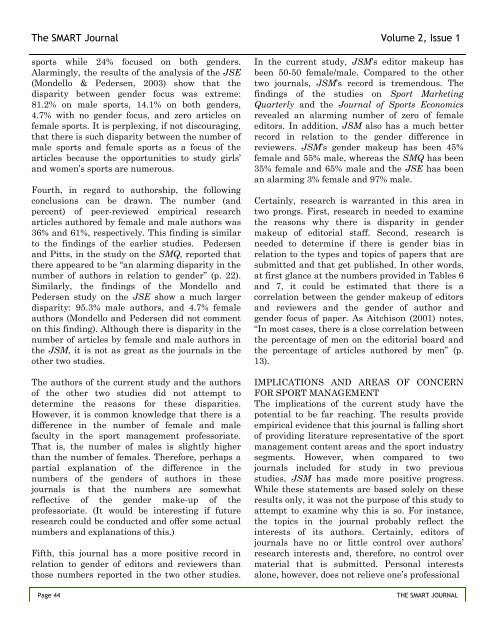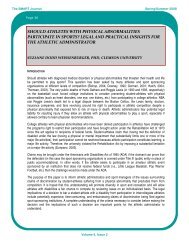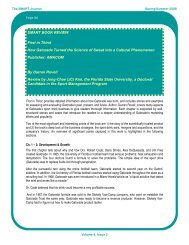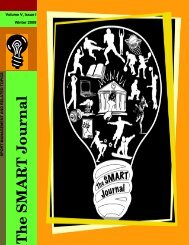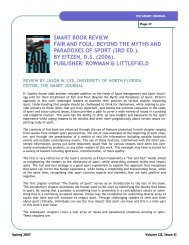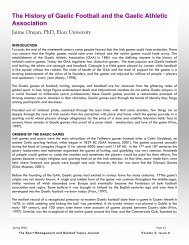examining the body of scholarship in sport management
examining the body of scholarship in sport management
examining the body of scholarship in sport management
You also want an ePaper? Increase the reach of your titles
YUMPU automatically turns print PDFs into web optimized ePapers that Google loves.
The SMART Journal Volume 2, Issue 1<strong>sport</strong>s while 24% focused on both genders.Alarm<strong>in</strong>gly, <strong>the</strong> results <strong>of</strong> <strong>the</strong> analysis <strong>of</strong> <strong>the</strong> JSE(Mondello & Pedersen, 2003) show that <strong>the</strong>disparity between gender focus was extreme:81.2% on male <strong>sport</strong>s, 14.1% on both genders,4.7% with no gender focus, and zero articles onfemale <strong>sport</strong>s. It is perplex<strong>in</strong>g, if not discourag<strong>in</strong>g,that <strong>the</strong>re is such disparity between <strong>the</strong> number <strong>of</strong>male <strong>sport</strong>s and female <strong>sport</strong>s as a focus <strong>of</strong> <strong>the</strong>articles because <strong>the</strong> opportunities to study girls’and women’s <strong>sport</strong>s are numerous.Fourth, <strong>in</strong> regard to authorship, <strong>the</strong> follow<strong>in</strong>gconclusions can be drawn. The number (andpercent) <strong>of</strong> peer-reviewed empirical researcharticles authored by female and male authors was36% and 61%, respectively. This f<strong>in</strong>d<strong>in</strong>g is similarto <strong>the</strong> f<strong>in</strong>d<strong>in</strong>gs <strong>of</strong> <strong>the</strong> earlier studies. Pedersenand Pitts, <strong>in</strong> <strong>the</strong> study on <strong>the</strong> SMQ, reported that<strong>the</strong>re appeared to be “an alarm<strong>in</strong>g disparity <strong>in</strong> <strong>the</strong>number <strong>of</strong> authors <strong>in</strong> relation to gender” (p. 22).Similarly, <strong>the</strong> f<strong>in</strong>d<strong>in</strong>gs <strong>of</strong> <strong>the</strong> Mondello andPedersen study on <strong>the</strong> JSE show a much largerdisparity: 95.3% male authors, and 4.7% femaleauthors (Mondello and Pedersen did not commenton this f<strong>in</strong>d<strong>in</strong>g). Although <strong>the</strong>re is disparity <strong>in</strong> <strong>the</strong>number <strong>of</strong> articles by female and male authors <strong>in</strong><strong>the</strong> JSM, it is not as great as <strong>the</strong> journals <strong>in</strong> <strong>the</strong>o<strong>the</strong>r two studies.The authors <strong>of</strong> <strong>the</strong> current study and <strong>the</strong> authors<strong>of</strong> <strong>the</strong> o<strong>the</strong>r two studies did not attempt todeterm<strong>in</strong>e <strong>the</strong> reasons for <strong>the</strong>se disparities.However, it is common knowledge that <strong>the</strong>re is adifference <strong>in</strong> <strong>the</strong> number <strong>of</strong> female and malefaculty <strong>in</strong> <strong>the</strong> <strong>sport</strong> <strong>management</strong> pr<strong>of</strong>essoriate.That is, <strong>the</strong> number <strong>of</strong> males is slightly higherthan <strong>the</strong> number <strong>of</strong> females. Therefore, perhaps apartial explanation <strong>of</strong> <strong>the</strong> difference <strong>in</strong> <strong>the</strong>numbers <strong>of</strong> <strong>the</strong> genders <strong>of</strong> authors <strong>in</strong> <strong>the</strong>sejournals is that <strong>the</strong> numbers are somewhatreflective <strong>of</strong> <strong>the</strong> gender make-up <strong>of</strong> <strong>the</strong>pr<strong>of</strong>essoriate. (It would be <strong>in</strong>terest<strong>in</strong>g if futureresearch could be conducted and <strong>of</strong>fer some actualnumbers and explanations <strong>of</strong> this.)Fifth, this journal has a more positive record <strong>in</strong>relation to gender <strong>of</strong> editors and reviewers thanthose numbers reported <strong>in</strong> <strong>the</strong> two o<strong>the</strong>r studies.Page 44In <strong>the</strong> current study, JSM’s editor makeup hasbeen 50-50 female/male. Compared to <strong>the</strong> o<strong>the</strong>rtwo journals, JSM’s record is tremendous. Thef<strong>in</strong>d<strong>in</strong>gs <strong>of</strong> <strong>the</strong> studies on Sport Market<strong>in</strong>gQuarterly and <strong>the</strong> Journal <strong>of</strong> Sports Economicsrevealed an alarm<strong>in</strong>g number <strong>of</strong> zero <strong>of</strong> femaleeditors. In addition, JSM also has a much betterrecord <strong>in</strong> relation to <strong>the</strong> gender difference <strong>in</strong>reviewers. JSM’s gender makeup has been 45%female and 55% male, whereas <strong>the</strong> SMQ has been35% female and 65% male and <strong>the</strong> JSE has beenan alarm<strong>in</strong>g 3% female and 97% male.Certa<strong>in</strong>ly, research is warranted <strong>in</strong> this area <strong>in</strong>two prongs. First, research <strong>in</strong> needed to exam<strong>in</strong>e<strong>the</strong> reasons why <strong>the</strong>re is disparity <strong>in</strong> gendermakeup <strong>of</strong> editorial staff. Second, research isneeded to determ<strong>in</strong>e if <strong>the</strong>re is gender bias <strong>in</strong>relation to <strong>the</strong> types and topics <strong>of</strong> papers that aresubmitted and that get published. In o<strong>the</strong>r words,at first glance at <strong>the</strong> numbers provided <strong>in</strong> Tables 6and 7, it could be estimated that <strong>the</strong>re is acorrelation between <strong>the</strong> gender makeup <strong>of</strong> editorsand reviewers and <strong>the</strong> gender <strong>of</strong> author andgender focus <strong>of</strong> paper. As Aitchison (2001) notes,“In most cases, <strong>the</strong>re is a close correlation between<strong>the</strong> percentage <strong>of</strong> men on <strong>the</strong> editorial board and<strong>the</strong> percentage <strong>of</strong> articles authored by men” (p.13).IMPLICATIONS AND AREAS OF CONCERNFOR SPORT MANAGEMENTThe implications <strong>of</strong> <strong>the</strong> current study have <strong>the</strong>potential to be far reach<strong>in</strong>g. The results provideempirical evidence that this journal is fall<strong>in</strong>g short<strong>of</strong> provid<strong>in</strong>g literature representative <strong>of</strong> <strong>the</strong> <strong>sport</strong><strong>management</strong> content areas and <strong>the</strong> <strong>sport</strong> <strong>in</strong>dustrysegments. However, when compared to twojournals <strong>in</strong>cluded for study <strong>in</strong> two previousstudies, JSM has made more positive progress.While <strong>the</strong>se statements are based solely on <strong>the</strong>seresults only, it was not <strong>the</strong> purpose <strong>of</strong> this study toattempt to exam<strong>in</strong>e why this is so. For <strong>in</strong>stance,<strong>the</strong> topics <strong>in</strong> <strong>the</strong> journal probably reflect <strong>the</strong><strong>in</strong>terests <strong>of</strong> its authors. Certa<strong>in</strong>ly, editors <strong>of</strong>journals have no or little control over authors’research <strong>in</strong>terests and, <strong>the</strong>refore, no control overmaterial that is submitted. Personal <strong>in</strong>terestsalone, however, does not relieve one’s pr<strong>of</strong>essionalTHE SMART JOURNAL


